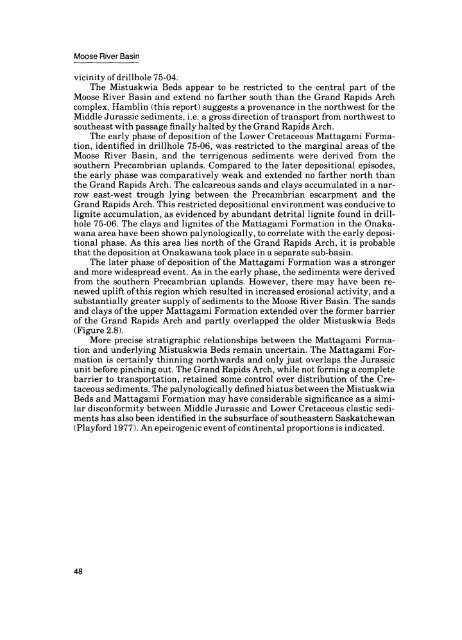Moose River Basin: geology and mineral potential - Geology Ontario
Moose River Basin: geology and mineral potential - Geology Ontario
Moose River Basin: geology and mineral potential - Geology Ontario
Create successful ePaper yourself
Turn your PDF publications into a flip-book with our unique Google optimized e-Paper software.
<strong>Moose</strong> <strong>River</strong> <strong>Basin</strong><br />
vicinity of drillhole 75-04.<br />
The Mistuskwia Beds appear to be restricted to the central part of the<br />
<strong>Moose</strong> <strong>River</strong> <strong>Basin</strong> <strong>and</strong> extend no farther south than the Gr<strong>and</strong> Rapids Arch<br />
complex. Hamblin (this report) suggests a provenance in the northwest for the<br />
Middle Jurassic sediments, i.e. a gross direction of transport from northwest to<br />
southeast with passage finally halted by the Gr<strong>and</strong> Rapids Arch.<br />
The early phase of deposition of the Lower Cretaceous Mattagami Forma<br />
tion, identified in drillhole 75-06, was restricted to the marginal areas of the<br />
<strong>Moose</strong> <strong>River</strong> <strong>Basin</strong>, <strong>and</strong> the terrigenous sediments were derived from the<br />
southern Precambrian upl<strong>and</strong>s. Compared to the later depositional episodes,<br />
the early phase was comparatively weak <strong>and</strong> extended no farther north than<br />
the Gr<strong>and</strong> Rapids Arch. The calcareous s<strong>and</strong>s <strong>and</strong> clays accumulated in a nar<br />
row east-west trough lying between the Precambrian escarpment <strong>and</strong> the<br />
Gr<strong>and</strong> Rapids Arch. This restricted depositional environment was conducive to<br />
lignite accumulation, as evidenced by abundant detrital lignite found in drill<br />
hole 75-06. The clays <strong>and</strong> lignites of the Mattagami Formation in the Onaka<br />
wana area have been shown palynologically, to correlate with the early deposi<br />
tional phase. As this area lies north of the Gr<strong>and</strong> Rapids Arch, it is probable<br />
that the deposition at Onakawana took place in a separate sub-basin.<br />
The later phase of deposition of the Mattagami Formation was a stronger<br />
<strong>and</strong> more widespread event. As in the early phase, the sediments were derived<br />
from the southern Precambrian upl<strong>and</strong>s. However, there may have been re<br />
newed uplift of this region which resulted in increased erosional activity, <strong>and</strong> a<br />
substantially greater supply of sediments to the <strong>Moose</strong> <strong>River</strong> <strong>Basin</strong>. The s<strong>and</strong>s<br />
<strong>and</strong> clays of the upper Mattagami Formation extended over the former barrier<br />
of the Gr<strong>and</strong> Rapids Arch <strong>and</strong> partly overlapped the older Mistuskwia Beds<br />
(Figure 2.8).<br />
More precise stratigraphic relationships between the Mattagami Forma<br />
tion <strong>and</strong> underlying Mistuskwia Beds remain uncertain. The Mattagami For<br />
mation is certainly thinning northwards <strong>and</strong> only just overlaps the Jurassic<br />
unit before pinching out. The Gr<strong>and</strong> Rapids Arch, while not forming a complete<br />
barrier to transportation, retained some control over distribution of the Cre<br />
taceous sediments. The palynologically defined hiatus between the Mistuskwia<br />
Beds <strong>and</strong> Mattagami Formation may have considerable significance as a simi<br />
lar disconformity between Middle Jurassic <strong>and</strong> Lower Cretaceous clastic sedi<br />
ments has also been identified in the subsurface of southeastern Saskatchewan<br />
(Playford 1977). An epeirogenic event of continental proportions is indicated.<br />
48

















